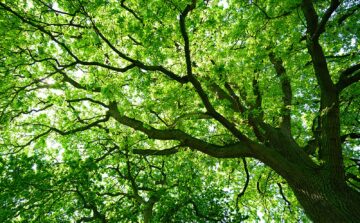Finding the Right Ash Tree Replacement in Minnesota
Many people across Minnesota are losing their ash trees because of Emerald Ash Borer (EAB), an invasive species of beetle from Asia. EAB larvae feed on the inner bark of ash trees, which disrupts the tree‘s ability to transport water and nutrients, causing the tree to die. Losing a shade tree, such as an ash, can make a significant impact on your landscape. There are no magic shortcuts to shorten the time it takes for a new tree to reach maturity. However, making an informed decision about what to plant as an ash tree replacement will give you the best chance at a fresh start with a tree that will thrive into the future.

How to choose the best replacement if you have to remove your ash tree
What type of tree should I plant as an ash tree replacement in Minnesota?
That depends! Many factors go into matching a tree type to its location, and it is impossible to get the best advice from a simple list. A certified arborist can evaluate your yard, along with the surrounding area, to make recommendations based on your goals and the unique conditions of your property. In the meantime, our experts have assembled this advice to help you get started.
General advice to consider when selecting an ash tree replacement
- Variety is key–avoid planting a tree species that you can see in your neighbors’ yards. If you like a tree a neighbor has—enjoy theirs and pick something different. Pests and diseases love to have all of their favorite targets conveniently located in one spot so they can spread from host to host, sowing destruction as they go. Don’t make it easy for them by repeating the mistakes of the past when many communities planted the same species.
- Plant a tree type that is well-adapted to climate change. Experts expect Minnesota’s weather to get warmer and for extreme rainfall events to increase, so plan ahead for zone hardiness.
- Purchase your ash tree replacement from a reputable source. Many cities offer tree sales in the spring, offering deep discounts and species chosen to promote species diversity. Local garden centers are also a great source and may offer a guarantee.
It is best to plan for a tree that will thrive in conditions found one or two USDA hardiness zones warmer than we are now. When we think of trees and climate, we tend to picture change happening over long periods of time. However, as rock climbers say, “Geological time includes now,” meaning rock structures may stand for thousands of years, but that doesn’t mean one won’t topple the day you happen to be there. This animated map from the Arbor Day Foundation shows how USDA Hardiness Zones have changed from 1990 to 2015.
How do I choose the best replacement tree to plant in my yard?

- Where will the tree be located?
- Will it be planted in a very sunny or shady area?
- Is the spot particularly wet, dry, or close to the road where it might be exposed to salt?
- Are there power lines or other overhead considerations that influence mature size?
- Is it in a spot where fruit or berries falling would be bothersome?
- Is having flowers or fall colors important to me?
- What types of trees are already common in my yard and on my block?
- What is the mature canopy size, and will this tree have enough room to grow?
What are some Minnesota tree species that are similar to ash?
This table summarizes the pros and cons of common shade trees. Within each type of tree described, there are many varieties. Any tree can be a poor match for your site, especially if there are already many of them in your neighborhood.
| Tree | Pros | Cons |
| Oak |
|
|
| Maple |
|
|
| Birch |
|
|
| Walnut |
|
|
| Aspen |
|
|
| Buckeye |
|
|
Additional frequently asked questions about replacement trees
What trees should I NOT plant in my yard?
What is the best fast-growing tree to replace my ash with?
While trees such as aspen, river birch, and red maple are very fast-growing, rapid growth is associated with serious concerns such as:
- Weak wood that will always be prone to breakage
- Less resilient to stress such as drought or heat
- Roots may grow quickly and interfere with retaining walls or sewer lines
- Shorter life span
- Often produce numerous seeds that litter yards and sprout in lawns and gardens
Our experts recommend weighing the pros and cons of a fast-growing tree when choosing an ash replacement.
When and how is the best way to plant a tree?
As a rule, spring and fall are the best times of year to plant new trees. Avoid common pitfalls such as planting the tree too deep or watering it improperly. To learn more, see our advice on Tree Planting Basics!

The experts at Rainbow Treecare can help you select the best replacement tree for your yard. Contact us to schedule a no-cost consultation!
Other items you may be interested in:

Consulting & Diagnosis
Tree Health Assessment, Consulting, & Diagnosis in Minnesota Are you worried about the health of a tree or shrub in your landscape? Getting it assessed

My City Tagged My Tree, Now What?
As Emerald Ash Borer (EAB) continues to impact trees across Minnesota and the Twin Cities metro area, some residents are returning home from work to

Tree Planting Basics for Minnesota Homeowners
There’s an old saying, “The best time to plant a tree is twenty years ago.” While it makes a humorous point about how long it



